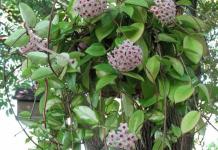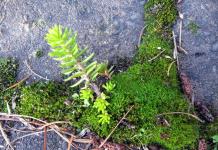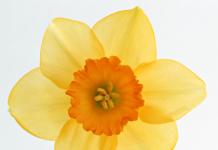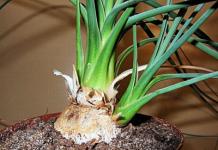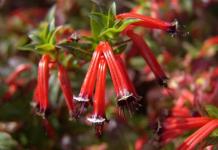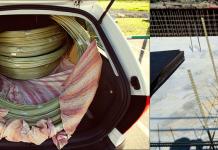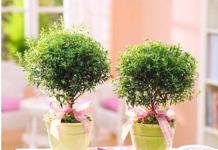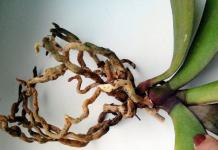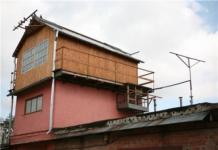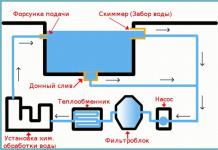Sedum is a perennial flowering succulent from the Crassulaceae family. The plant's homeland is the dry slopes and meadows of America, Africa and Eurasia. It is used to decorate a site or room, as well as for medicinal purposes. The Latin name translates as “to pacify,” which is associated with the drug’s ability to reduce pain. The Russian name comes from the word “cleanse”, since taking the decoction helps cleanse the intestines. In addition to these names, such names as “hare cabbage”, “creak” and “fever grass” are known.
Description of the plant
The sedum flower is a low-growing herbaceous succulent with a perennial or biennial life cycle. All varieties can be divided into heat-loving tropical ones, which in our latitudes are grown as indoor plants, and winter-hardy, ground cover. Due to its branched stems, sedum forms a subshrub or shrub.
Fleshy petiolate leaves of oval or ovoid shape sit on dense shoots. They can be completely flat (disc-shaped) or swollen, like small cylinders. The leaves are arranged oppositely or in whorls. Their color can be green, grayish or pink. The color of the leaves depends not only on the type and variety, but also on the growing conditions - in bright sun or in the shade, exposed to wind, depending on the composition of the soil. The foliage of even one species can be green or covered with reddish stains.















In summer or autumn, sedums bloom in dense umbellate inflorescences consisting of small, star-shaped, bisexual flowers. Flower colors are white, yellow, blue, and red. The bent petals grow together into a narrow tube, from the center of which a bunch of long thin stamens and an ovary style peek out. Flowers emit a pleasant aroma that attracts beneficial insects. Sedums are good honey plants.
Species diversity
The sedum genus is very large. About 600 plant species are registered there. Only a few of the most beautiful plants are used in culture and for decorative purposes.
An inhabitant of East Asia grows up to 50 cm in height. It grows a tuberous rhizome and has erect, bare stems. Oval leaves without petioles grow on the shoots. They are colored bluish-green and are concave in the center. The edges of the leaves are jagged or wavy. In summer, umbrella inflorescences with a diameter of up to 15 cm bloom. They consist of small (up to 1 cm), star-shaped flowers of lilac-pink color.

Large sedum, also common and medicinal. The perennial, 25-30 cm high, has an erect, thick stem with flat, sessile leaves. The edges of the oval leaves are serrated. Plants bloom very profusely in the second half of July. They are considered an excellent honey plant. The top of the stem is decorated with a dense corymbose inflorescence, consisting of many small stars with long stamens. Varieties:
- Matrona - erect stems up to 60 cm high are covered with large blue-green foliage with a reddening edge, they bloom with light pink lush inflorescences;
- Linda Windsor - dark burgundy stems with dark red foliage culminating in ruby hemispherical inflorescences.

The succulent perennial, 20-60 cm high, has erect, evenly leafy stems and a tuberous rhizome. Flat, fleshy leaves grow alternately. Their length is 3-10 cm. Small, rich pink umbrellas bloom in June-September.

Fleshy, lodging stems up to 20 cm long are covered with cylindrical green leaves that turn pinkish or purple in autumn. Already at the end of spring, loose inflorescences bloom on bare peduncles 12-15 cm long with white stars.

Thick branched stems up to 10 cm in height are covered with alternate flat, oval-shaped leaves with jagged edges. The length of the sheet does not exceed 6 mm. Loose inflorescences with sessile buds of a golden yellow hue bloom on shortened peduncles. Flowering occurs in May-June.

The winter-hardy plant has a long creeping rhizome and creeping stems. Fleshy, dark green, egg-shaped leaves grow opposite. They have crenate or jagged edges. The inflorescence in the form of a thick umbrella contains purple or pink flowers.

The Mexican species grows shoots up to 1 m long; they spread along the ground, forming a dense carpet. Numerous round or oval leaves grow 1.5-2 cm in length and 5 mm in thickness. They are colored light green. Each peduncle ends with a dense umbrella of 10-15 pink or red buds.

A herbaceous perennial with creeping rhizomes grows 30-40 cm in height. The erect stems are covered with oval leaves with smoothed teeth along the edges. Orange flowers bloom in summer.

Branched reddish stems form a compact bush 30 cm high. They are covered with opposite heart-shaped leaves with a flat structure 2-5 cm wide. The edges of the leaves have a pink edge. The same pink stars with pointed petals appear towards the end of summer. They are collected in large inflorescences, which cover the bush with a continuous cap.

Garden variety with lodging shoots covered with awl-shaped bluish-green leaves. In spring, dense golden-yellow inflorescences bloom on bare peduncles up to 30 cm long.

Reproduction methods
Sedums reproduce quite easily. To do this, gardeners have the following methods available:
- Sowing seeds. Freshly collected seeds in autumn or early spring are sown in prepared containers with sandy-peaty soil. Small seeds are distributed evenly on the surface, and sprinkled with a thin layer of wet sand on top. The container is covered with film or glass. To undergo stratification, the pots are transferred to a room with a temperature of 0...+5°C for 2 weeks. The soil is regularly moistened and condensation is removed. Then the container is returned to a warm room (+18...+20°C) and after 15-30 days shoots appear. They grow so massively that the entire earth is covered with a green carpet. From now on there is no need for shelter. Seedlings with 2 leaves carefully dive. They are kept in bright, diffused light and room temperature. On warm days, seedlings are taken outside for hardening.
- Cuttings. Sedum stems take root easily when in contact with the ground. Shoots of any size and even individual leaves are used as cuttings. The cuttings are chapped within a few hours, but why are they planted in garden soil with a lot of sand? And they just press it lightly into the ground. Water the cuttings occasionally. In a few weeks they will take root and begin to grow.
- Dividing the bush. A large, overgrown plant is propagated by dividing the rhizomes. In the spring it is dug up, carefully freed from the ground and cut into pieces. Each should have several sprouts and buds. The cut areas are treated with a fungicide and dried, and then planted in fresh soil.
Planting and care in open ground
In the garden, sedums are given a well-lit place. They can grow in partial shade, but bloom worse. You should not plant sedums under deciduous plants, so that they are not covered with leaves in the fall.

Planting is carried out at the end of May, when stable warm weather has established. The area is dug up and, if necessary, humus and compost are added. Shallow holes are dug in rows with a distance of 20 cm. The plant is suitable for any soil, even poor soil, rocky embankments and sandstones. Decorative varieties require more fertile soil. After planting, abundant watering is required. Flowering is expected from 2-3 years of life.
Care involves regular weeding, as the plants suffer from the dominance of weeds. The exception is caustic sedum, which is able to cope with weeds on its own.
The fleshy leaves accumulate enough fluid to survive short-term drought. On hot days in the absence of precipitation, sedums must be watered. Water should not stagnate in the soil for a long time, as the plants will suffer from fungal infections.
Sedums do not need regular fertilization. Most species manage without feeding at all. Decorative varieties are fertilized twice (in April and August-September). Half a serving of universal mineral fertilizer is enough.

Plants are trimmed regularly. You should also remove wilted inflorescences and old, bare shoots. Over time, sedums degenerate and age, so they are rejuvenated every 5 years.
Frost-resistant garden plants in late autumn, after severe cold weather, are cut almost to the ground. Leave stumps 3-4 cm high. They are sprinkled with fresh soil. In spring, new shoots will appear from the roots.
Sedum is usually resistant to plant diseases. Only with prolonged flooding of the soil can fungal infections develop. Their symptoms are darkened, soft leaves with a putrid odor. Damaged areas must be removed to healthy tissue and the plantings must be treated with a fungicide.
Insects quite rarely settle on plants. Most often these are aphids, thrips, weevils and caterpillars. Insecticides and acaricides will help get rid of pests.

Caring for indoor sedum
At home, sedum can grow no worse than in the garden. For heat-loving tropical varieties, this is the only way to survive the frosty winter. The pots chosen are small and wide. The soil is made up of:
- turf land;
- rotten leaves;
- peat;
- river sand.
Drainage material is laid at the bottom. The soil should be moderately moist or dry. Immediately after planting, they try not to disturb the plant and keep it in the shade. A few days later it is exposed to the sun.

In summer, the room is regularly ventilated. You can expose the pots to fresh air.
Watering should be moderate throughout the year so that the earthen ball dries out by a third.
If the flower has not been replanted for a long time and the soil is depleted, a weak solution of mineral or organic fertilizer is poured into the soil every month.
Medicinal properties
Sedums contain many substances beneficial to humans:
- alkaloids;
- vitamins;
- tannins;
- glycosides;
- slime;
- flavonoids;
- saponins;
- coumarins.
The above-ground part of the plant is used as a medicinal raw material. It is cut off during the flowering period. Decoctions, water and alcohol tinctures, as well as extracts are prepared from raw materials.
The drugs have tonic, healing, anti-inflammatory, diuretic, stimulating, analgesic and laxative effects. They are used internally and externally for scurvy, constipation, malaria, burns, gout, atherosclerosis, nervous disorders and other diseases.
You can strengthen your own health with the help of all types of sedum, but caustic sedum is used with great caution. Treatment is completely contraindicated for pregnant and lactating women, children, as well as people suffering from hypertension and nervous excitability.
Succulent plants sedum (sédum lat.) belong to the Crassulaceae family. The growing area is very diverse: from Eurasia to the northern and southern parts of America. Contains species and varietal diversity.
At the same time, the common name of the plant is sedum. Unpretentious in care, requires proper and constant care. Widely used in the world of landscape design, in various compositions.
About the plant
Refers to a perennial herbaceous plant. However, it is rarely even two years old. Forms solid stems with leaves that tend to accumulate water. Stem height ranges from 40 to 70 cm, depending on the type. In this case, the stems are: erect, creeping and turf-forming. Contains small actinomorphic flowers resembling a star shape.
The bright palette of flowers is varied with primary colors: red, white, pink, yellow. It has the following inflorescences: umbellate, corymbose and racemose. Flowering occurs in summer or autumn. Large tuberous root system. Mainly grows in meadows and dry slopes. Has good winter hardiness.
Historical reference! The Russian folk name for sedum is “feverish or hernia grass.”

Six-row sedum (Sedum sexangulare)
Types and varieties
Initially, the genus of sedum consisted of approximately 600 species. Over time, the number of species decreased to 300. Currently, only about 100 species are bred and grown. Each type of sedum contains a large number of varieties that differ from the main type in the color of the stem, flowers and leaves. Photos of flowers clearly show the uniqueness of each species.
Type of sedum acrid (Sedum ácre)
Perennial plant species. Has a thin root system. Numerous erect stems with fleshy dark green leaves. The inflorescence contains golden-yellow flowers, with a calyx length from 2 to 5 mm. Flowering lasts from mid-spring to late summer. Drought-resistant and winter-hardy.
Important! Acrid sedum is a honey plant, but its juice produces a dangerous poison.
The most popular varieties:

Morgan's Sedum (Sedum morganianum)
A perennial plant native to Mexico. Due to the densely foliated light green leaves and branches spreading up to 1.5 meters in length, the species received the second name “monkey tail”. Actinomorphic axillary flowers in the form of red-pink stars, located at the end of the stem, up to 2 cm in diameter. Flowering begins in early spring.
The most common varieties of Morgan are:
- Harry Butterfield (sedum Harry Butterfield): has pointed leaves that are lighter in color;
- Burrito (sedum burrito): characterized by rounded leaves with a bluish tint.


The bluish tint of the leaves of the sedum Morgana "Burito"
Type of sedum reflexed or reflexum /sedum reflexum/
Evergreen perennial plant. Distributed in central and northern Europe, as well as in the central part of the Caucasus. Spreads low along the surface of the earth. Narrow bluish-green leaves are densely planted on short stems. They may also have a pink or silver tint. Blooming with yellow flowers lasts from June to July. Grows well at any temperature.
Fact! Sedum reflexum is classified as an edible plant. The sour taste of sedum harmonizes perfectly in salads and in many dishes.

Type of false sedum (sedum spurium)
Perennial low-growing plants with creeping and erect stems. They grow in the southwestern part of Asia. In the Russian Federation - on the territory of the Caucasus. The oval-shaped middle leaves contain serrated edges. Small purple flowers are collected in dense inflorescences. As a result, the species has another name - purple carpet. They have winter hardiness.
False sedum has the main varieties:

Sedum spectabile species
The homeland of sedum is East Asia, especially China. The tall species is characterized by an erect stem with light green leaves. The inflorescences contain small pink flowers. Flowering occurs in September.
Varieties of prominent sedum:
- sedum Carl: contains bluish leaves; umbrella-shaped inflorescences of purple-carmine or pinkish-lilac flowers;
- Matrona (sedum matrona): has dark green leaves and light pink flowers;
- Neon (sedum neon): Contains grayish leaves and pink inflorescences.

Handsome "Karl".

Majestic "Matrona".

Sparkling "Neon"
Kamchatka sedum species (sedum kamtschaticum)
It is widespread in the Far East, on its rocky slopes. Belongs to a perennial, low-growing species. Contains erect stems with dark green leaves. The corymbose inflorescence contains yellow-orange flowers. Flowering – July – September. The root system has a lignified appearance. Tolerates the winter well.
Of all the varieties of this species, the variety “Golden Carpet” stands out the most: the second name is yellow rose, because of the bright yellow flowers.

White sedum species (sedum album)
Perennial sedum is common in the north of our country. Forms a low creeping carpet of green stems and small leaves. The inflorescence is paniculate and contains fragrant snow-white flowers. It is winter-hardy and grows well in partial shade.
Common varieties:
- coral carpet: or white moss, forms a creeping canvas of blooming flowers;
- hillebrandtii: Flowers are orange in summer and pink in winter.

Landing
Correct and high-quality planting of sedum is based on step-by-step actions. You should familiarize yourself in more detail not only with the planting process itself, but also with the choice of seedling and location.
Selection of seedlings
The seedling must undergo a thorough inspection before planting. It is necessary to choose healthy plants. Seedlings with various damage, signs of disease or the presence of pests are excluded. When examining the leaves, you need to make sure that there are no limp specimens. You should pay attention to the soil, which does not allow stagnation of water and excessive moisture. It is also necessary to decide on the variety for the composition, since varieties differ in the color of the leaves, the length of the shoots and the color of the flowers.
Advice! The low variety is suitable for flower canvas, and the high variety is suitable for group and single planting.
Selecting a location
Sedum is a light-loving plant. It is necessary to choose an open sunny area with good soil, without stagnant moisture. The sun's rays have a beneficial effect on the decorative properties of leaves. Plant parameters and leaf color are taken into account for a harmonious combination in the area with other crops. Creeping and groundcover varieties thrive in rocky and rocky areas. Some varieties can grow in shaded areas, but their stems become significantly elongated.
Soil preparation
The unpretentious sedum grows well in a variety of soils. However, for full development and lush flowering, all types of plants require a special composition. All this should be taken into account when choosing a site. Fast-growing groundcover varieties require light, loose soil rich in nutrients. Other varieties prefer loamy, sandy, or lime-rich soil. Before planting, in any case, it is worth digging up the area, adding a small amount of compost or humus to the soil.
Landing technology
Sedum is planted after a period of spring frosts. The time for planting is May. The interval between plants should be not less than 20-25 cm.
Landing includes the following sequence:
- dig a hole up to 20 cm deep, with a diameter of up to 50 cm;
- mix sand with humus in a ratio of 3:1;
- distribute drainage in one layer at the bottom of the pit;
- fill the hole with the prepared composition;
- make a small depression in the middle of the hole, to the depth of the root system of the seedling;
- carefully place the seedling into the hole;
- sprinkle with soil, pressing gently with your hands;
- mark the hole by placing small stones around the plant;
- put fine gravel or crushed stone in the hole;
- water the seedling.
Attention! Planting a plant in a dark place can lead to depletion of leaves and stems, and in the future it will stop blooming.

Care
Proper care is the key to not only a healthy appearance of the plant, but also abundant flowering. Necessary components: watering, fertilizing and, to a lesser extent, loosening.
Watering
Sedum does not like waterlogged soil. In the first period after planting, the plant requires regular moderate watering. This contributes to its rapid rooting and good adaptation. At a more mature age, watering is carried out during prolonged heat or drought. A guide to soil dryness is an elementary hand test; if the soil is so dry that it is cracked, then it is necessary to water. If, when loosening, fresh, slightly damp soil is visible, it is too early to water.
Loosening
Thanks to the process of loosening around the sedum, unnecessary weeds are eliminated and the soil is enriched with oxygen. In addition to loosening, a mulching process is carried out, which keeps the soil in a loose state and enriches it with nutrients. Various mulches can be used for plants.
Top dressing
No special feeding is required for all types of sedum. For the season, it will be sufficient to apply fertilizer only twice: before flowering and after it. Apply liquid organic fertilizer using nitrogen in small quantities until flowers form. At the end of flowering, use complex fertilizer.
Advice! Fading sedums should be cut back in the fall. This promotes renewal and rejuvenation of plants.
Growing from seeds at home
Propagation by seeds is easy and simple. It is enough to thoroughly prepare for this process. Seeds are planted for seedlings from the beginning of March to the end of April. Before planting, they first undergo stratification and preparation for transplanting seedlings as follows:
- The seeds are laid out on the soil surface in a small container and moistened.
- Cover with a plastic bag and place in the lower section of the refrigerator, at a temperature of 0 to 5 degrees Celsius.
- After two weeks, they are transferred to indoor conditions.
- Subsequently, if the temperature is maintained at 18-20 degrees, and with moderate soil moisture, the first shoots appear after a month.
- When 1-2 true leaves are reached, it is necessary to plant the seedlings into pots.

You should prepare the soil for plant pots in advance, which should include the following components: sand, peat, rotten leaves and turf in equal proportions. For better soil structure add brick chips. First, a drainage layer is laid on the bottom of the pot, and then the prepared mixture. Then the soil must be loosened and watered evenly. A sedum seedling is planted in a hole in the middle of the pot, sprinkled with soil and watered.
The first days after planting, the seedlings are kept in a dark place. As plant growth increases, they are moved to a sunnier location. Caring for a plant in a room requires regular ventilation and even watering. Sedum grows very well at home and takes root quickly.
Application in landscape design
The decorative effect of each variety and the uniqueness of the leaf palette allows you to create beautiful compositions in landscape design.
Sedum (sedum) will decorate any landscape - country, garden, city. The creeping perennial will decorate any area and hide all kinds of design defects and unsightly areas. Bright flower stars will cheer you up even on a cloudy day.
Sedum ácre is a herbaceous perennial belonging to succulents. The plant of the Crassulaceae family has been known to people since ancient times.
It is no coincidence that it has many other names - “rejuvenator”, “feverish or hernia grass”, “whip” and even “living water”.
Natural habitat - North Africa, Europe. In Russia, it is found naturally in western Siberia, Ciscaucasia. It chooses sandy and dry places for growth - wastelands, embankments, rocky slopes. Found on forest edges and clearings.

The rhizome of the sedum is thin, highly branched, resembling a bunch of tangled cords. Thanks to this rhizome, the plant receives enough moisture from the soil. During prolonged drought, the flower produces surface roots to catch droplets of dew and rain.
The rising stems of sedum do not exceed a height of 15 cm. Their height depends on the composition of the soil. On poor rocky soil they reach only 7 cm, but under favorable conditions they grow to their maximum. The stems are covered with small, fleshy leaves that are ovoid in shape. Their color is green, it can be dark or light (depending on the planting location and lighting). Special fabrics of the sheet plate accumulate moisture.
The leaves do not fall off in winter; the succulent remains green throughout the winter.
The short inflorescences consist of golden-yellow flowers. Among the five opened petals, 10 stamens are clearly visible. The buds open in May - June, depending on climatic conditions. Flowering lasts until September, after which the seeds ripen. The plant is an excellent honey plant, producing a lot of nectar even in dry weather. Many insects are attracted by the sweet aroma of flowers.

Young bushes take root well and grow quickly. As soon as the short shoots touch the soil, they immediately try to cling to it. Over the course of the season, the succulent grows and by the next summer it is ready to delight flower growers with abundant, bright blooms.
There is a legend about the ability of sedum to be reborn. If you put dried sedum in the ground, sprinkled with soil, it will come to life and sprout!
Varieties

This variety of sedum is a decoration for alpine hills and rockeries. It grows quickly, forming lush mats, the height of which is about 8 cm. Small, fleshy green leaves are densely located on ascending stems. Shoots spreading along the ground quickly grow adventitious roots.
Flowering occurs from May to July. Golden-yellow flowers are collected in inflorescences. When they bloom, the green mat changes color, becoming yellow from the numerous opened flowers. During flowering, the foliage also acquires a yellowish tint.
Sedum Aureum is hardy and unpretentious: it is not afraid of drought and frost, and does not lose its attractiveness on poor soils.

The groundcover plant, reaching an average height of 10 cm, forms turf with a diameter of 20 cm. On branched stems, succulent leaves of green, bluish or purple color are alternately located. Their shape is slightly twisted. The foliage remains on the shoots throughout the winter. Abundant flowering begins in June and lasts about two months. The flowers are light yellow in color and have a diameter of approximately 1.5 cm. During flowering, the perennial “grows” up to 20-30 centimeters.
Sedum Elegance is planted in containers, on rocky walls and alpine hills. A separately planted plant looks impressive as a bright carpet spot or emphasizes the beauty of tall plant crops in the neighborhood.
Sedum acre Minus

A very low-growing decorative variety of sedum acridus, forming a mat, the height of which barely reaches 10 cm. The fleshy leaves, which have a bluish-green color, look like small cylinders that turn pink in the sun. Blooms profusely with yellow flowers.

The flower is popular not only among professional flower growers, but also among beginners. It looks unusual both in group and single plantings. The plant is not afraid of frost.
Features of cultivation
Sedum caustic is able to adapt to any climate. It requires a minimum of care; gardeners say about it: plant it and forget it.
Selecting soil and planting location
Sedum is not picky about soil fertility. On the contrary, it feels good in sandy, sparse areas. A loose clay-sand substrate is what the plant needs. You can add a little ash and humus to this mixture.
The simpler the soil composition, the more abundant the flowering.
If the flower is not picky about the composition of the soil, then good lighting is extremely important for it. It is best to plant it in the sunniest area. It will, of course, grow in the shade, but it will not please you with flowering.

Watering, fertilizers, fertilizing
Sedum growing in open ground requires virtually no watering. It receives the required amount of moisture from the soil and precipitation. Watering is needed only during the dry summer period, and then only moderately. Excessive waterlogging of the soil is detrimental to this type of succulent. In its natural environment, the perennial chooses dry areas for growth. There is no need to spray sedum.
The perennial does not need fertilizing. If you really want to feed it, it is enough to apply fertilizer for cacti once a summer.

Loosening
Transfer
When transplanting several sedum bushes to a new location, it is important to maintain a certain interval between them - at least 25 cm. This distance is necessary for the growth of daughter shoots. You can replant throughout the warm season: from May to October.
Divisions or rooted cuttings are placed in the planting hole, sprinkled with soil substrate, and watered with a small amount of water.

Trimming
Pruning should be carried out in order to rejuvenate the sedum and give it a decorative appearance. The procedure can be performed at any time convenient for the grower, from spring to autumn.
The appearance of the perennial will itself indicate the need for pruning: with extensive growth and thickening, the color of young leaves will become faded, and the flowers will become sparse and very small.
In this case, the old stems of the sedum are removed, dried and deformed, and drooping flowers are also cut out.

Wintering
Adult specimens feel good at low temperatures, maintaining their attractiveness even under snow. Young bushes require winter shelter. They can be covered with fallen leaves or special covering material. In spring, release the sedum from its shelter.
Reproduction methods
Sedum acrid can be propagated in three ways.
Cuttings
Cut off the shoot for planting with a sharp knife. Remove the lower leaves. Plant it in a loose substrate for rooting to a depth of one node. Plant the rooted cuttings (after 3-4 weeks) in a permanent place.
In spring, cuttings can be rooted immediately in open ground, when frost has passed. In autumn, cut shoots should be placed in water until roots appear. Then plant them in separate containers. In the spring, transplant into an open area using the transshipment method for continuous growth.

Seeds
It is better to sow seeds in March. After sowing, they must undergo a stratification (hardening) procedure. Seeds in a planting container are placed in a cool place for 2 weeks. After this, they are placed in a warm place for germination with a temperature of at least 18 degrees. The top of the box must be covered with film or transparent glass to create a greenhouse effect. The crops are ventilated daily and moistened as the soil substrate dries.
In about 25–30 days, the first shoots will emerge. Seedlings are picked when two strong leaves appear.
At the end of May - beginning of June, seedlings are planted in open ground in a permanent place. The distance between plants should be at least 10 cm for further growth. Sedum blooms in the third year after planting.

Dividing the bush
Dig up a heavily overgrown bush and divide it into several parts, each of which should have a growing point. Sprinkle sections of the root system with charcoal or treat with fungicides. Replant to a new site.

Possible problems
Improper care of the plant will affect its decorative effect:
- spots on the leaves occur when there is an excess and swampiness of the soil substrate;
- the color of the leaves has changed: the color of the leaf blades has faded. This happens when there is a lack of sunlight, frequent fertilizing or excess salts in the soil;
- The sedum has stopped blooming, which means it grows in the shade and is deprived of light throughout the day.
Diseases and pests
Excess and stagnation of moisture in the soil can provoke the formation of rot on the root system. The disease spreads quickly if it is not stopped in time.
The “sluggish” leafless shoot needs to be dug up, the rotten roots should be cut off, and the cuts should be sprinkled with coal. Plant the reanimated plant in a new area. Another way to save it is to root the top of the succulent.
The roots of perennials are often affected by a fungal infection, which manifests itself in the form of swellings, growths and death of rhizome tissue. The methods of control are the same as for the formation of rot. Healthy parts are treated with fungicides.
The most dangerous pest for sedum are nematodes.

Sedum caustic is a decoration for any landscape: from urban to garden. It looks ideal both in flower beds in composition with other plants, and as an independent carpet. An overgrown perennial will hide various border defects and decorate unsightly areas in the garden.
Useful properties and contraindications
A representative of the Crassulaceae family has medicinal properties. Decoctions and ointments, which include sedum, are used to treat skin inflammations and pustules, calluses, and remove warts. It is necessary to carefully lubricate only the diseased areas; healthy skin can be burned.
In homeopathy, preparations with plant juice are used as laxatives and diaphoretics. They help relieve epilepsy attacks.
Do you have any doubts about what to plant in your garden plot? Plant caustic sedum - a minimum of care for this representative of the flora will save time for busy gardeners. And the result will not be long in coming - sunny inflorescences and decorative foliage will evoke only positive emotions.
Sedum, sedum, hare cabbage are unpretentious succulent plants, the care of which consists of proper planting, timely watering, fertilizing and rejuvenating pruning to form a lush bush. During flowering, they form such a lush carpet that, looking at them, a beautifully woven tapestry pattern appears. The charm of a lint-free carpet is given not only by sedum flowers, but also by fleshy, dense, impressively colored leaves. Sedum is an excellent honey plant, so a myriad of bumblebees, bees and butterflies will circle over the luxurious carpet. The ancient Romans firmly believed that sedum protected houses from lightning strikes, so they planted it on roofs and fortifications.
Botanical description
Sedum is a herbaceous, low-growing succulent plant. In nature, there are perennial and biennial sedums. All types of succulent sedums can be divided into 2 parts. The first are heat-loving, which in our harsh climate are grown only as annual plants. The second are frost-resistant, ground cover.
Under natural growing conditions, it is widespread in the Caucasus, has populated the arid regions of South America and Africa, and can also be found here in Russia.
The stems of sedum are quite branched; when they grow, they form a lush shrub or subshrub. The leaves are very dense and adhere well to the fleshy stems. Petiolate leaf blades often have an ovoid or oval shape. You can find specimens with swollen, cylinder-like leaves, or with flat, disk-like leaves, arranged in whorls or oppositely.
When sedums are blooming, you can’t take your eyes off the interesting, unlike anything else flowers
Leaf plates can be painted gray, green, gray, pink. Their color depends not only on belonging to a particular species, but also on the growing conditions. The color is influenced by weather conditions, such as bright sun or partial shade, soil composition, exposure to winds or not. Even one species may differ in foliage color if growing conditions are noticeably different. Sometimes reddish stains may appear on the leaves.
Dense umbrella flowers appear on the plant in the second half of summer, some varieties bloom in autumn. The umbellate inflorescences contain small bisexual flowers, colored red, blue, yellow and snow-white.
The petals are very dense, slightly bent. As they grow, they grow together into a narrow tube from which numerous stamens and the ovary peek out. The flowers smell so good that they attract pollinating insects.
Types, description, photo
Common sedum
A tall perennial plant with an erect thick stem reaching a height of 25 cm. The leaf blades are dense, flat, petiolate. The edges of the oval leaves have serrations. Abundant flowering occurs in July. A corymbose dense inflorescence appears at the very top; it includes numerous star-flowers with beautiful stamens. Medicinal sedum is considered a good honey plant.
Common sedum is represented by two popular varieties: Matrona and Linda Windsor.
The erect stems of Matrona reach 60 cm in height. The blue-green foliage is covered with a reddish coating. During flowering, the bush is covered with beautiful light pink inflorescences.
The flowering of sedum is somewhat reminiscent of the medicinal plant St. John's wort.
Linda Windsor
Linda Windsor
Famous for its dark burgundy stems. During flowering, ruby-colored hemispherical inflorescences bloom above the dark red foliage.
Prominent
Prominent
It grows naturally in the countries of East Asia. The plant is considered medium-sized, the stems reach a height of 50 cm. The root system of the species is represented by a tuberous rhizome. Bare stems grow straight. They bear tightly adjacent petiolate leaves. The blue or bluish-green plates have a noticeable depression running closer to the center.
In summer, a cap of umbrella-shaped inflorescences appears above the wavy, slightly jagged foliage, the diameter of which is equal to 15 cm. Each inflorescence contains lilac-pink star-shaped flowers.
Purple
Purple
Perennial succulent plant. Depending on the variety, the height of sedum varies between 20-65 cm. Dense leaves are evenly spaced on erect stems. Sedum reproduces by tuberous rhizome.
The fleshy foliage has a regular arrangement. The length of the leaf blade ranges from 3 to 9 cm. Umbrella inflorescences of soft pink or deep pink appear above the beautiful foliage from June to September.
The color saturation of purple sedum flowers depends on the quality of the soil and growing conditions.
Caustic
Caustic
The stems of this plant species are well branched and do not exceed 10 cm in height. The oval leaves fit tightly to the stems, with small denticles clearly visible along their edges.
The leaf blades are small, their length is 6 mm. Shortened flower stalks boast loose inflorescences in which golden-yellow buds sit tightly.
White
White
Green leaves sit tightly on the creeping fleshy leaves of white sedum. The shape of the leaf plates resembles numerous cylinders. Over time, the bright green foliage turns reddish, purple or pink.
White star flowers appear on the plant in late spring. At this time, the sedum throws out long, bare peduncles. The diameter of loose inflorescences reaches 12 cm.
False
False
The species is characterized by good winter hardiness, has creeping stems and creeping rhizomes. The foliage is dark green, arranged oppositely, and has an oblong ovoid shape.
Purple or pink umbrella-shaped inflorescences appear above the serrated foliage.
Morgana
Morgana
A thermophilic species, it can be found in natural conditions in Mexico. Morgan's sedum can only be grown as a houseplant in our conditions.
Hare cabbage grows very long shoots that cover the ground with a dense carpet and reach a length of at least 1 m. The plant produces long flower stalks, at the top of which there are dense umbrella inflorescences with reddish or pink flowers.
Evers
The compact bush consists of reddish, well-branched stems, reaching a height of 30 cm. The stems have heart-shaped leaves. Their structure is flat, 2.5 cm wide.
Flowering occurs at the end of the warm season. Large inflorescences with pink flowers cover the plants with a thick hat. Along the edges of the serrated foliage there is a clearly visible pink or red border.
Kamchatsky
Kamchatsky
A perennial plant with a creeping rhizome, thanks to which the species reproduces well and covers the entire area provided to it with a dense carpet.
The oval leaves along the edges have noticeable smoothness of the teeth. Yellow-orange flowers appear above the beautiful light green foliage.
Bent back
Bent back
It belongs to the garden variety, has lodging shoots, to which bluish-green, awl-shaped leaves are tightly adjacent.
Flowering begins in early spring. At this time, the plant produces bare peduncles on which golden-yellow flowers bloom.
Siebold
Siebold
An indoor variety of succulent plant. It is grown in a hanging pot as an hanging plant. The blue-green small leaves fit tightly to the long, lodging stem.
The leaves are collected in whorls of 3. During flowering, the plant is covered with beautiful numerous inflorescences with bright pink, sometimes crimson flowers.
Weinberg
Weinberg
Sedum has ovoid leaves that are colored blue-gray. When examining the foliage, a waxy coating is clearly visible.
The stems are erect, but during the growing season they fall to the ground under the weight of dense leaves. The foliage of Weinberg's sedum is collected in a beautiful symmetrical rosette.
Linear Lineare
Lineare
Miniature indoor plant. The stems are very thin, well creeping. Compact bushes are completely covered with beautiful foliage.
All varieties of sedum are beautiful in their own way. Among the variety of species, each gardener can choose a variety and a specific species that can be grown outdoors or choose an indoor flower to decorate the interior.
Rules for planting and care in open ground
Successful cultivation of sedum depends on the conditions that can be provided to it in a given area. When planting species, you need to take into account their characteristics of growing in natural conditions in order to try to bring them closer to natural ones.
Selecting a location
Sedum comes from warm countries, so you need to choose a well-lit area for growing., without any shading. If you plant sedum in partial shade, this fact will not affect the growth and development of the plant, but you will have to wait a little longer with flowering, and it will not be so lush.
Soil composition
There is an established opinion that sedums will grow on any soil, even sandy soil, you just need to add a little humus to it.
However, in fertile soil, sedums show themselves in all their glory.
Sedums do not like dampness; excessive soil moisture can lead to rotting of the root system.
Sedum, or hare cabbage, as it is popularly called, naturally grows mainly on sandy or rocky soil. Due to the fact that the plant is not demanding on growing conditions, many varieties can be used to create incredible compositions in the shape of animals.
Without compromising growth and flowering, sedums can grow in the same place for 5 years. The overgrown curtain will need to be rejuvenated, divided into several parts and transplanted to another place. Add fresh soil, crushed stone and sand to the remaining specimen.
Fertilizer application
When planting in a new place, add ash and sand to the soil. For good growth and development, plants need fertilizing with mineral and organic fertilizers.
Decorative sedums require 2-fold fertilizing throughout the entire growing season.
The first is held in April, the second in August. It is better to feed with special fertilizers for succulents. When preparing the solution, it is necessary to adhere to half the concentration.
Perennial sedums are fed with nitrogen-containing fertilizers only at the beginning of vegetative growth - in the spring . Apply nitrogen in the fall is strictly prohibited, as it can impair sensitivity to low temperatures.
Many gardeners use caustic sedum to control weeds. In addition, traditional healers prefer caustic sedum to all other medicines in the fight against warts.
The beauty and fleshiness of the leaves, as well as their richness, depends on whether the plants receive enough nutrients
At the beginning of the growing season, as was said, they are fed with organic fertilizers. For this purpose, infused mullein is used. When preparing the solution, mullein is diluted with water in a ratio of 1:10. Sedum does not like fresh manure.
Transfer
It is better to replant plants in the spring. Humus and mineral fertilizers are added to the soil for planting, I dig it with a shovel and level the surface with a rake. Sedum can be planted in rows. It is advisable to leave 10-15 cm between specimens, and 20 cm between rows. This distance will allow the plant to grow well.
The transplant should be completed with abundant watering. Weekly care consists of loosening the soil, timely watering and weeding the soil from weeds.
Sedums have fleshy leaves that store water “in reserve”
However, prolonged overdrying of the earthen coma can lead to the death of the plant. Abundant watering should be carried out in dry times, when hot, sunny weather lasts for a long period.
Excessive waterlogging has a detrimental effect on sedums, as the plant can be damaged by fungal diseases.
Pruning sedums
The procedure is simply necessary, since the plants grow very quickly, the stems can become bare and the cluster takes on an unkempt, sloppy appearance. Therefore, in relation to sedum, it is necessary to carry out formative, sanitary and rejuvenating pruning. Haircut should be regular. When inspecting the plant, it is necessary to remove all damaged and weakened shoots.
Perennial varieties resistant to frosty winters are pruned in late autumn. The optimal time is a strong cold snap. During this period, all stems are cut to the ground level with the soil. The remaining stumps are covered with covering material or the soil near the plant is mulched. With the arrival of spring, many young stems form on the bushes.
Decorative pruning is carried out to give the plant a compact appearance. All manipulations are performed carefully, using sharp and disinfected instruments.
If you find plain leaves on an ornamental variety with variegated foliage, you will need to cut them off completely.
Sedum in indoor floriculture
Growing sedum at home is even easier than growing it outdoors. It is only important to choose the right varieties.
For planting, you need to select shallow containers
Soil composition for successful cultivation:
- turf soil - 2 parts
- peat – 1 part
- rotted leaves - 1 part
- river sand – 1 part
Expanded clay or pebbles must be placed in each pot, because without drainage the root system of the plant can rot. Before planting, the soil needs to be moistened, but the entire soil should not be allowed to be too wet.
Hanging succulents
The planted plant should not be disturbed at first. Watering is carried out only after the top layer of soil has completely dried 1 cm deep. After planting, young specimens are kept in partial shade. Thus, they quickly adapt to new conditions, recover from stress and begin to develop. Then the pot with the plant is placed on the windowsill so that its beautiful fleshy foliage is bathed in the sun and receives warm baths.
Fleshy, rich foliage indicates that the plant has enough mineral and organic fertilizers
Sedum loves fresh air, so it is recommended to regularly ventilate the room, but avoid drafts. In the summer, a pot with a plant can be taken out to a loggia, balcony, terrace, or placed in a semi-shaded place in the garden. It is recommended to replant adult specimens once every 2 years.
Reproduction
At home and when grown outdoors, you can easily get new sedum bushes, since they reproduce very easily and take root quickly.
There are several ways to propagate sedum:
- propagation by seeds
- cuttings (variety – winter cuttings)
- rhizome division
Let's consider each method of obtaining new copies in more detail, identifying all the positive and negative aspects.
Seed propagation
For sowing, you can use your own seeds collected from plants in the flowerbed. You can buy planting material in the store. Bright sunlight and prolonged exposure to the open sun lead to a change in the color of the leaf plates.
It does not lose its decorative effect; on the contrary, it acquires an attractive reddish tint. Seeds can be sown in spring or autumn. It is necessary to pour a soil mixture consisting of sand and peat into the containers.
Sedums have small seeds, therefore, to distribute them evenly over the surface of the earth, you need to mix them with dry river sand
It is worth considering that only freshly harvested seeds have good germination, so when purchasing it is important to pay attention to the expiration date. The earlier the seeds were collected, the greater the likelihood that they will germinate 100%.
Seeds are sown superficially and not covered with soil. It is advisable to moisten the soil before sowing. So that later during moistening you do not bury the seeds into the soil. The container must be covered with film or glass.
Under natural growing conditions, seeds undergo natural stratification - they lie under snow all winter and are exposed to sub-zero temperatures. Domestic seeds need to create the same conditions. The container with the sown seeds can be placed in the refrigerator for 2 weeks or taken outside and buried in a snowdrift.
Under natural conditions, sedums can be found in unusual places, that is, where their growth seems impossible. And the seeds of the plant or cuttings of sedum are brought into such hard-to-reach places by birds or mice.
After passing the stratification, the container with the seeds is brought into the house and placed on a well-lit windowsill with a room temperature of at least +18 °C. After about half a month, the first shoots appear. The germination process can take a whole month.
The shoots are so friendly that the entire surface becomes covered with a continuous carpet. When two true leaves develop on young specimens, the young plants must be planted in separate pots and given plenty of space for good development.
Cuttings
Flower growers note that propagating sedum by cuttings means saving a lot of time and nerves, since this method is the simplest and most effective. Survival rate is almost 100%. In order for the sedum to take new roots, it only needs to come into contact with the ground.
After the cutting is torn from the mother plant, it is necessary for it to lie on the table at room temperature for several hours so that the cut dries out a little.
The cuttings are only slightly buried in the soil. Watering should be rare. When the plant develops its root system, it will begin to massively grow foliage.
Young plants are ready for transplanting into open ground after 2 weeks from the formation of the root system. Further growing in containers does not make sense, since the plants will begin to stretch and the stem will become bare and unattractive.
Decorative composition
Winter cuttings are used by gardeners to massively increase the collection, that is, to fill large areas with sedum. Designers for landscaping recommend using sedum. When it fades, you cannot wait for frost; you should cut off all the shoots and spread them out in an even layer in a fairly warm room.
While the plants are “basking in the warmth,” they will first lose all their foliage and the stems will remain leafless. After some time, young shoots begin to form in place of the fallen leaves.
Now you need to wait until these shoots reach a length of 6 cm. They need to be broken off and buried in the soil for rooting. Cuttings root well at room temperature. They are not afraid of increases and decreases in temperature. The only thing that sedum cuttings are afraid of is being in damp soil for a long time at a low room temperature. In such conditions, cuttings may rot.
Rhizome division
In addition to seed propagation and cuttings, some varieties are propagated by dividing the rhizome
These include:
- sedum prominent
- common sedum
- red dotted sedum
When the plant grows widely, it can be divided and planted in different places, filling the free space with them. To do this, in early spring you will need to remove the mother plant from the ground, shake off the soil and divide the bushes so that each section has its own growing points and buds.
The fleshy leaves of sedum contain many useful substances. The vegetative part of the plant is used as a medicinal raw material.
Chemical composition of sedum:
- vitamins
- tanning agents
- alkaloids
- coumarins
- flavonoids
- glycosides
- saponins
For medicinal purposes, it is necessary to harvest the aerial part during flowering. For treatment, decoctions, tinctures of water and alcohol, and healing extracts are prepared.
When preparing medicinal infusions and other remedies, it is important not to skip the preparation time so that all the nutrients do not “evaporate” from the plant.
All types of sedum are used to treat diseases, except caustic. This variety should be used with caution or not at all.
Contraindications to taking sedum-based products:
- pregnancy and lactation
- nervous excitability
- hypertension
- children under 18 years of age
Preparations that include sedum have a tonic, anti-inflammatory, healing, analgesic, stimulating, diuretic and laxative effect.
Oral intake is indicated for the following diseases: ka scurvy, atherosclerosis, malaria, nervous shock, constipation, gout. For burns, it has a wound-healing effect.
Unpretentious garden flowers. Sedum prominent
Sedum: types and varieties for growing at home and in open ground. Rules for planting and caring for a succulent plant (110+ Photos & Videos) + Reviews
Some plants attract attention not with their exquisite large flowers of unusual shapes, but with their large inflorescences. A large number of small sedum buds, collected in dense brushes or umbrellas, can become a real decoration of a flower bed. The succulent has taken root in gardeners’ cottages and apartments, delighting them with lush greenery and a sea of small flowers. Let's consider the features of planting and caring for sedum, the best types and varieties of flowers.
The Latin name of the culture is Sedum. The plant is a succulent and belongs to the Tolstyankov family.
Most species grow as perennials, some as biennial crops. The variety of forms often makes the sedum unrecognizable - the sedum grows as a lush bush or tightly weaves the soil with a real carpet. Sedum has dense, fleshy leaves that accumulate moisture and protect against drying out. The leaf blades are colored green, gray, and often have pink streaks. The color of the foliage depends on living conditions.
Flowers are collected in inflorescences in the form of a brush, umbrella or corymbose. Almost all types of sedum have a pleasant smell and are honey plants. The color of sedum flowers is varied - pink, white, blue, yellow. Blooms in summer and autumn. In nature, sedum is ubiquitous. There are more than 500 species, of which about a hundred are cultivated. Many varieties and hybrids have been created for landscaping areas. Tropical species are grown at home.
Features of application in landscape design
Large sedum inflorescences and bright, juicy greenery can decorate any area. In landscape design, many varieties are used in flower beds to create “velvet” pictures with alternating colors. Sedum bushes look great near ponds. Sedums are planted along the edges of flower beds, to create a border, and along garden paths. Dense planting of low varieties creates dense lawns that look good even in the absence of flowers - due to the decorative foliage. Creeping forms will hide the gaps of alpine slides and rockeries.
Benefits of growing at home
Flower growers have been growing sedum at home for a long time. To ensure flowering, special conditions must be met:
- moderate watering;
- decrease in temperature in winter (10-12 °);
- warmth and sun (south side) in summer;
- timely feeding.
Sedum blooms only with experienced gardeners who can provide the necessary conditions. Even in the absence of flowers, sedum pleases with decorative greenery and the beauty of the bush. Many people value the plant for its medicinal properties. It is used as a biostimulant, similar in action to aloe leaves. The succulent leaves are used for wounds and skin injuries, and they make healing infusions for heart pain and hypotension.

Information: close relatives of sedum are Crassula, Kalanchoe, Echeveria.
Types and description of sedum varieties
Sedum grows everywhere, the variety of natural forms is great. Plants are so different in appearance that it is sometimes difficult to believe that they belong to the same family. Let's consider the most popular and favorite types and varieties of sedum.
Ground cover
When creating a harmonious flower garden, ground cover plants with creeping stems come to the rescue. They cover the soil and serve as a backdrop for other crops. Sedums green the area with a beautiful lush carpet, which is colored with bright spots of buds.

Cornflower
Sedum stems grow 8-10 centimeters. The tops of the stems with leaves of a gray-green hue look like flowers themselves. The buds are pink-purple, reaching 0.5-0.6 centimeters when opened. They bloom in August.
Sedum Siebold
It has thin recumbent stems and fleshy leaves, collected in whorls of 3 pieces. The leaves are round, with a red tint along the edge. The flowers are pink, collected in thick umbrellas or shields.
Forster's sedum
Covers the entire area with a dense, low (10 centimeters) carpet. The foliage is gray-green, interspersed with pink. Yellow flowers rise 20-30 centimeters. Looks good hanging down in a pot.

Divergent
A low creeping plant hides all the gaps in flower beds with a thick carpet 5 centimeters high. The foliage turns pink in the sun. The flowers rise slightly above the green mass and can be pink or yellow.
False
A wonderful plant native to the Caucasus. False sedum is grown on alpine hills and used for landscaping sloping roofs. It has a long creeping rhizome and quickly spreads over a large area. The leaves are wedge-shaped, the flowers are pink-purple, the inflorescences are without upper leaves. It blooms for a long time - from June to October.

Caustic sedum
The natural species of sedum is successfully grown as a cultivated plant. A short sedum (8-10 centimeters) covers the entire area with a thick green carpet. In mid-summer it is covered with abundant yellow flowers, attracting bees with a pleasant smell.
Lydian
Lydian sedum covers the ground with real thickets, the stems are covered with a large number of medium-sized elongated fleshy leaves. Grows well in the shade. The flowers are white and rise low above the foliage.

Sedum Eversa
Evers' sedum is used for landscaping pebble slopes and screes. The plant is planted on alpine hills and used to hide bare areas near the house. Blooms in July, flowers last up to 2 months. The foliage is decorative, growing densely on smooth stems. The buds are densely located on corymbose inflorescences. Petals are light pink or crimson.
Subulate
In nature, awl-shaped sedum grows on the mountain slopes of the Caucasus. Shoots with a large number of subulate-linear fragile leaves of a yellow-green hue. The inflorescence is corymbose, dense, with white flowers.
Six-row
Sedum grows up to 8-18 centimeters, the stems branch strongly right from the base. The foliage is cylindrical in shape and grows very densely on the side shoots. The leaf color is green.

The inflorescences are loose, bright yellow flowers are sparsely arranged, shaped like small stars. Planted in a large group or alternating with other species.
Ampelny
Ampelous varieties and types of sedum are popular for cascading decoration of garden plots and apartments. They look good in pots and flowerpots.
Among the most favorite:
- Morgana. Sedum has stems that grow up to a meter and are strewn with thick, cylindrical leaves with pointed tips. Blooms with pink-red buds. Called "monkey tail".
- Siebold. The stem hangs 20-25 centimeters, the leaves are round in shape, of different shades.
- Burrito. Similar to Morgana, the edges of the leaves are round.
- Small leaf Makinoy. Sedum with small leaves of different colors.
- Mexican. An ampelous bush with shoots up to 20 centimeters and thin leaves. In the sun the foliage turns yellow, the flowers bloom yellow.

All ampelous species are unpretentious and develop well with a lack of sun. When grown in pots, regular watering is required.
Shrubs
Sedums with tall bushes and flower stalks are more popular among gardeners. They are clearly visible in flower beds; they are planted in separate clumps or form large groups of different shades. Their stems do not cover the ground, so the crops need regular watering.
Red dotted
The peduncle of the sedum rises to 60 centimeters, the color of the buds is white and different shades of pink. The foliage is not particularly bright, gray-green in color. The main difference between red-spotted sedum is its late flowering, which occurs in September. It is not worth planting in cold regions.

tenacious
The herbaceous perennial is found naturally in the Far East and Siberia. Grows on forest edges, meadows, rocky slopes of rivers. Refers to poisonous plants.
Ordinary
The tall-stemmed type of sedum is among the most popular. Popular garden varieties have been created on its basis. The bright, petiolate leaves have denticles on the edges. The peduncle rises 40-60 centimeters. Flowers bloom at the end of July. The corymbose inflorescence is densely packed with buds, the opening flowers look like stars. The best varieties are Matrona, Linda Windsor.
Prominent
A natural species, it came from Asia and has long been cultivated in Japan. The bush is erect, grows up to 60 centimeters. The leaves are sessile, dense, green. The inflorescences stand on a dense stalk, the diameter is up to 15 centimeters. The flowers are pink or carmine-red, each size is no more than 10 millimeters.
The prominent sedum became the ancestor of many varieties - Neon, Xenox, Diamond.
Adolf
Evergreen shrub with many stems. Young foliage is green and fleshy; with age, yellow and pink tints appear. The inflorescences are hemispherical, the color of the petals is white. When grown indoors, it blooms with difficulty.
Redleaf
Red-leaved or red-colored sedum is a shrub with falling shoots that rise with age. The leaves are distinctly green with a red ending. The flowers are yellow.

Rural
Selskogo sedum has woody stems up to 40 centimeters high. A flower of yellow tones on a short peduncle, the inflorescence is an umbrella. This type of sedum is not widespread. The bush grows slowly and requires sunny areas and regular watering.
Purple
The dense foliage of sedum will become a real decoration of the garden. Sheets with carved edges are covered with a waxy coating. Pink flowers stand out beautifully against its background. The peduncle rises up to 70 centimeters. The stems are dense, the tall bush does not fall apart and keeps its shape. Blooms in July.

The foliage has a slightly sour taste; it is consumed fresh or fermented.
Yellow
Yellow or pale yellow sedum has green, brown foliage, sometimes with a bluish tinge. The flowers are yellow. Winter-hardy, unpretentious appearance. A popular variety is Red Wiggle.
Sedum hybrid Abbeydor
Low bushes (35-40 centimeters) are covered with abundant green foliage. Flower color is purple-pink. The bush is falling apart. The inflorescence is corymbose and very dense, with an abundance of buds. Used in mixborders.

Growing sedum in open ground
When growing sedum, it is important to imagine what type of plant you will get. Many varieties cover large areas of soil with their stems and entwine their neighbors.
Selecting a location
The sedum is planted in a well-lit area. Light shade is allowed only for part of the day. Without enough sunlight, the bushes become elongated and the color of flowers and leaves suffers. Succulents do not like excess humidity; low-lying areas with stagnant water are not used. If necessary, drainage is done to dry the soil. For the same reason, you should not plant a bush under trees that drop their leaves in the fall.

Preparing the ground
Sedum does not have any special requirements for soil composition and grows well on any soil. It is important to ensure drainage and avoid the accumulation of puddles. If the groundwater level is high, the beds are raised. The soil is dug up and weeds are carefully removed. Heavy clay soils are lightened with sand or fine gravel. To increase fertility, humus is added.
How to sow seeds: timing and technology
In warm regions, sedum can be sown with seeds in the spring, directly into the ground, when consistently warm weather has established. Most gardeners prepare seedlings in advance.

Basic rules for planting sedum:
- Sedum is planted for seedlings in March-April.
- Soil composition – sand, humus, fertile soil in equal parts.
- Container – depth – 10-15 centimeters, with a laid drainage layer.
- Dilute the soil well and leave it to soak.
- Place the seeds in shallow grooves and cover with soil.
- Cover with film.
- Water with a spray bottle as it dries.

Planting seedlings
Ready sedum seedlings are transferred to open ground when the danger of frost has passed. For different regions this is the beginning or end of May. Holes for seedlings are made at a distance of 15-20 centimeters, using recommendations for planting this plant variety. The root system of the sedum is small; the seedling cannot be buried. Holes 20 centimeters deep are sufficient. After planting, the plants are watered abundantly.
Information: flowering of sedums begins 2-3 years after planting.
Plant care
Sedum is considered an unpretentious crop; most varieties do not require special care. It is important to remove weeds in a timely manner, carefully removing them from the beds. Weeds clog the sedum and slow down its growth.

Watering
Sedum does not need frequent regular watering. Sedum is watered only during dry summers, 2-3 times per season. The crop tolerates excess water worse than too little. After watering, the soil is loosened, creating oxygen access to the soil. Do this carefully due to the shallow roots.
Fertilizer application
Sedum does not need a lot of feeding. Ground cover species do not need to be fertilized. Particular care is taken to apply fertilizing with nitrogen, which disrupts the decorative appearance of foliage and reduces frost resistance.
It is permissible to feed tall sedums 1-2 times per season with complex fertilizers with phosphorus and potassium.
Transfer
In one place, sedum can grow for up to 5 years. In the future, the bush ages and needs rejuvenation. When updating the bush, it can be transplanted to another place. The bush is dug up in the spring, when the growing season has not yet started vigorously, and the soil is shaken off. Cut into pieces with a clean tool so that each has roots and buds. Leave for several hours in a shaded place. The sections are lubricated with fungicides. Planted in a new area.

Trimming
Dried sections of the stem and damaged leaves are regularly cut off. On bushes with colored foliage, green shoots are cut off to maintain the decorative appearance of the plant. In September or October, the bush is pruned for winter, so it is easier to protect the plant from frost.
Pests and diseases: control and prevention
In rainy summers and with excess watering, sedum suffers from fungal infections. Rot spots appear on stems and leaves. Damaged parts of the bushes are cut out, and the plants are treated with fungicides.
The most common pests that attack sedum are caterpillars, weevils, aphids, and thrips. For cleaning, insecticides of appropriate action are used.
Sedum is little susceptible to disease. When choosing a dry, ventilated area without strong shading and little watering, it does not cause any trouble for summer residents.
How does a flower winter over?
In autumn, plants lose their leaves. In tall sedum bushes, in preparation for winter, the stems are trimmed, leaving 3-4 centimeters. Dried flower stalks remain decorative, so bushes are often left near houses until spring. You can prune overwintered stems when the snow melts, before the growing season begins. In cold regions, plantings can be insulated with loose soil, river sand or fine gravel. If necessary, sprinkle snow on top.

Methods of propagation of sedum
Reproduction of sedum is not particularly difficult. New plants are produced by vegetative division and from seeds. Let's take a closer look at each method.
Seeds
Many gardeners obtain seeds from their own plants. To obtain seed, you need to let the flower stalks dry until they are completely dry and carefully cut them off. This is not easy to do; sedum blooms for a long time, often until the snow, and the seeds do not have time to ripen.
Important: sedum hybrids do not produce full-fledged seeds; parental properties are not transmitted.
You can plant seeds as seedlings at home or directly in open ground. The second method is only suitable for warm regions.

Cuttings
Most types of sedum are easy to propagate from cuttings. This method is considered faster and more reliable. In the spring, a cutting with 1-2 buds is cut from the bush and deepened into the ground 2-3 centimeters. The bottom sheets need to be cut off to prevent rotting. The prepared cuttings can be rooted in a pot and then transferred to the ground. When cutting cuttings in the fall, you will have to grow young seedlings at home. Sedum cuttings are placed in water and wait for the roots to grow. After this, they are planted in separate pots.
The transfer of sedum to the soil is carried out in the spring, when warm weather sets in.
Sedum reproduces easily; a stem that falls to the ground quickly takes root and forms a young plant. This property is used if sedum is already growing on the site. The soil around the adult bush is cleaned, loosened, and fertilized. Press the stem to the ground with a pin and water. Rooting occurs quickly. When cuttings are taken, the young bush completely retains the properties of the old plant.

Dividing the bush
Dividing one bush into several is another way to propagate sedum. It is good, if the sedum has already stayed in one place, it’s time to rejuvenate the plant. When dividing, it is important to remove the old part of the roots and bush, to create viable layering with roots and buds.
Division is carried out when the main processes of vegetation have not yet begun, the plant is not in the stage of active growth.
Any gardener can grow and propagate sedum. The plant does not have a capricious character, grows well in drought conditions, and does not require frequent feeding, pruning, or bush formation. Sedum attracts bees with its pleasant smell and promotes pollination of neighbors. The healing properties of sedum are another undoubted advantage of the plant.
Using different types of sedum, you can decorate alpine slides, flower beds, and create borders. Sedum differs favorably from other flowering plants by its highly decorative foliage and bush. A wide variety of species and varieties allows you to design the site in accordance with the characteristics of the territory and personal tastes.


